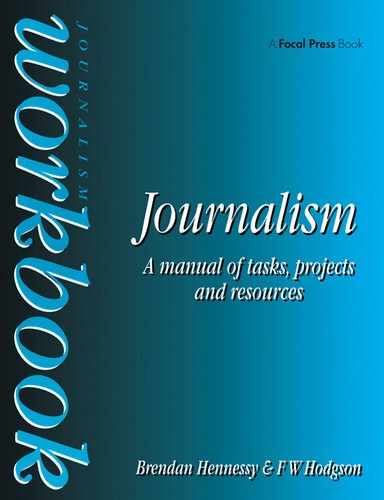
Introduction
THERE are many training routes in journalism in Britain today. To the traditional courses conducted by the National Council for the Training of Journalists and the many Higher National Diplomas in journalism and its fringe areas have been added in recent years the industry-based National Vocational Qualifications (NVQs). Spurred on by NVQs and their demand for trained lecturers and assessors at those centres undertaking them, in-house training schemes have become more widely avail-able among the main newspaper companies, and also better organized. Some offer their own specialized diplomas as well as NVQs in an attempt to attract the best entrants to their staff.
Meanwhile, the media have penetrated the academic world on a broad front with more universities offering degrees in media studies, and finally in journalism itself. This has made Britain increasingly sought after by Commonwealth and other overseas students seeking qualifications rooted in British practice and has greatly increased the numbers of journalism students in the country as well as trainee journalists. Correspondence courses and learning packs are winging their way abroad in a new wave, bringing more overseas students than ever within the orbit of British journalism training.
Media studies degrees were originally much concerned with the psychology of language and communication and the morality of the press, all valid aspects of study. In recent years they, too, have increased their vocational content in film, PR, broadcasting and print journalism - in what one assumes must be response to student demand — and are becoming more commonly chosen as first degrees by graduates entering the industry’s training schemes. Syllabuses, however, should be carefully scrutinized for content by those students looking to take up careers in the media.
Textbooks have to take account of this burgeoning activity. In a world in which journalism and its techniques are increasingly under the microscope, the Focal Press Journalism Manuals, published by Butterworth-Heinemann, break new ground with Journalism Workbook, a manual of hands-on tasks covering all aspects of practice.
Here is a book that will be a boon not only to in-house tutors and trainees but to students on journalism and media studies courses and those grappling with learning packs, or simply their own burning ambition, who have yet to work ‘in the field.’
The authors take each area of practice and demonstrate with the use of practically based, assignments the world of work that awaits young journalists in the early years of their careers. Each assignment is designed to spin off a number of tasks which are spelt out in the form of briefings. With these are notes and book references to help the trainee or student tackle them and also further their knowledge of the particular area of practice. Students are recomended to study the background texts to hone their skills.
The exercises can be used on courses or as a self-administered extension of course work carried out under the guidance of tutors or lecturers. Above all, they are intended to help tutors and students by providing models for further course work based upon the skills required of their staffs by today’s newspapers and magazines.
Assignments range from reporting and news writing to feature writing, subediting and headline writing and press photography. Assignments on page planning and design are included to help journalism students and trainees understand the principles by which newspapers are put together and targeted on their audiences, and to give a flavour of the more esoteric world of the production journalist.
General questions of the relationship between newspapers and their readers and the place of the press in society are not neglected. Workshop projects and study programmes outline ways in which students and trainees, working in groups or singly, can study and analyse newspaper content, build up readership profiles and consider methods of practice, social attitudes, press regulation and press economics.
The book outlines ways in which vocational training can be extended through research into the press and its methods by means of debate, seminars and the submission of long papers on a chosen press subject.
The chapter on sources and the appendix on books, publications and organizations are designed to make young journalists confident in identifying and acquiring — and knowing where to look for — information needed for the many tasks with which they are likely to be faced.
The authors finally consider the thorny subject of marking and assessment, including self-assessment, and suggest ways in which the assignments, projects and study programmes in this book — or ones derived from the models given — can be used to measure achievement within the parameters of the training programmes for which they are used.
Journalism Workbook is not a textbook as such but rather a guide on how to utilize textbooks alongside fieldwork and the requirements of syllabuses in the process of learning to be a journalist. Practical work in the field plus sound theoretical instruction are both necessary to the young journalist starting out, This book is offered as the bridge between the two.
For the benefit of those concerned with particular aspects, each chapter has an introductory outline covering its area of practice and has been made as self-contained and easy-of-reference as possible.
